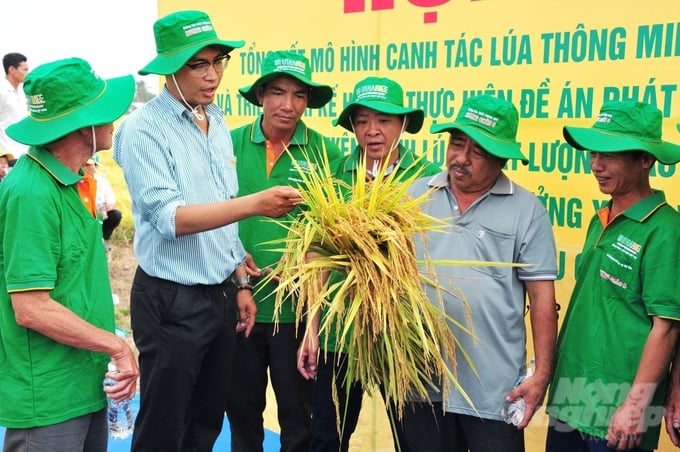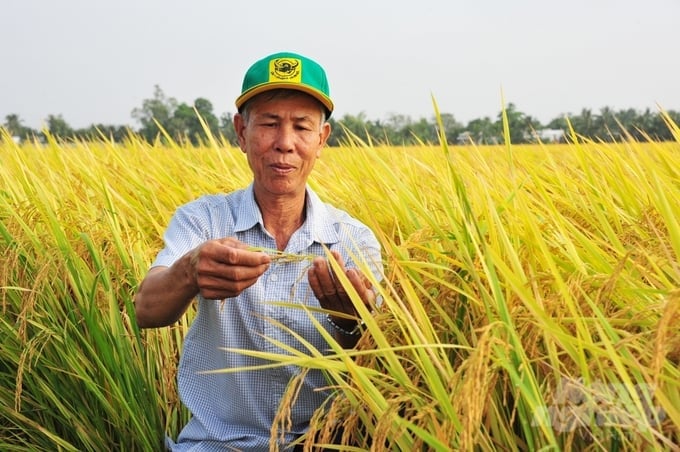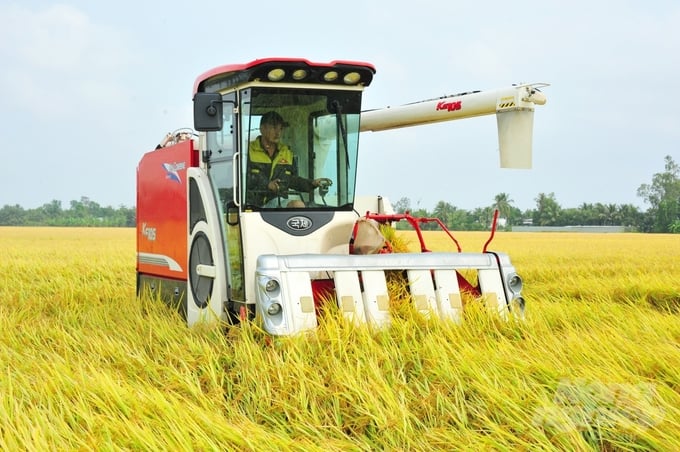November 21, 2025 | 13:55 GMT +7
November 21, 2025 | 13:55 GMT +7
Hotline: 0913.378.918
November 21, 2025 | 13:55 GMT +7
Hotline: 0913.378.918

Participants of the closing workshop for the Smart Rice Farming Model for the 2023 - 2024 Winter-Spring Crop. Photo: Hoang Vu.
The National Agricultural Extension Center, in collaboration with Hau Giang Provincial People's Committee, organized a closing workshop for the Smart Rice Farming Model for the 2023 - 2024 Winter-Spring Crop on March 13, in Vi Thanh city, Hau Giang province. Furthermore, the workshop deployed the sustainable implementation plan for the Project "Sustainable development of 1 million hectares of high-quality and low-emission rice production in association with green growth in the Mekong Delta region." The event was attended by the heads of the Department of Crop Production, the Department of Plant Protection and the National Agricultural Extension Center, scientists, accompanying businesses, and local cooperatives and farmers.
Prior to the workshop, the participants visited the smart low-emission rice farming model in association with green growth in the Mekong Delta region at the fields belonging to Mr. Nguyen Van Ut Em in Hamlet 12, Vi Trung commune, Vi Thuy, Hau Giang province. Most notably, the government of Hau Giang province, in collaboration with the Ministry of Agriculture and Rural Development and local companies, utilized the same area to organize a demonstration of mechanization and the establishment of smart rice farming models during the land preparation and sowing phase. This demonstration model acted as a touring stite for the Vietnam - Hau Giang International Rice Festival 2023, which was held from December 12 to December 16, 2023.
The smart rice farming model fields utilizes various technical measures, input products and services provided by the four accompanying businesses, namely: Vietnam Rice Company Limited (VinaRice), Binh Dien Fertilizer Joint Stock Company, Saigon Kim Hong Trading Services Company Limited, and Bayer Vietnam Limited.

The smart rice farming model is estimated to produce a yield of nearly 10 tons of fresh rice per hectare for the 2023-2024 winter-spring crop, with a total profit of approximately 65 million Vietnamese dong per hectare. Photo: Hoang Vu.
Accordingly, the smart rice farming model utilizes the RVT-certified rice seeds provided by Vietnam Rice Company Limited for sowing. The sowing process is facilitated by the cluster seeding machineries provided by Saigon Kim Hong Trading Services Company Limited, with a seeding rate of 60 kilograms per hectare, or approximately 8 kilograms per cong (1,300 m2). The seeds are precisely sown with a row spacing of 25 centimeters, and a cluster spacing of 16 centimeters, with each cluster containing between 7 and 10 seeds, thereby effectively utilizing the border effect.
The model fields are fertilized using specialized Dau Trau fertilizer following the recommended procedure by Binh Dien Fertilizer Joint Stock Company, including a basal application of fertilizer during land preparation for sowing to promote strong early growth of rice plants. This procedure can effectively reduce losses and cut down on fertilizer usage by at least 30% compared to that of traditional farming methods. The model utilizes the Much More Rice care and protection techniques provided by Bayer Vietnam Limited to increase productivity, enhance quality, and boost profits.
The smart rice farming model represents a continuation to the "Smart Rice Farming model in adapting to climate change in the Mekong Delta region." In addition to training and knowledge transfer for smart rice farming processes, establishing demonstration models in cooperatives and among farmers in major production areas is essential to effectively transfer the process to farmers.
The model does not have a comparative control group. However, there is a significant reduction in seed and fertilizer usage compared to that of the local average production, with the most contrasting features being the reduced amount of nitrogen fertilizer and number of pesticide round. Furthermore, the model evaluates rice quality and pesticide residue through sampling, and comparing analysis with neighboring farmers' products. Subsequently, analysis results have indicated improved rice quality, increased rice recovery ratio during milling, and the absence of pesticide residue.

The smart rice farming model fields utilizes various technical measures, input products and services provided by the four accompanying businesses, with a focus on reducing costs, increasing quality, and boosting profits for farmers. Photo: Hoang Vu.
This is the first model to employ the analysis of rice quality and pesticide residue, with the aim of meeting the increasingly stringent requirements imposed by various markets around the world. Reportedly, the pesticide residue levels are at a safe level, thereby ensuring rice quality.
At the time of writing, the model rice fields have reached their harvesting stage. The sample harvesting produced a yield of nearly 10 tons of fresh rice per hectare. With an on-field contracted purchase price of 8,800 Vietnamese dong per kilogram, the total revenue is estimated to reach 88 million Vietnamese dong per hectare, resulting in a profit of nearly 65 million Vietnamese dong per hectare after deducting expenses. This profit level is at least two times higher than that of traditional practices employed by local farmers.
During the rice harvesting tour, Saigon Kim Hong Trading Services Company Limited showcased a combined harvester manufactured in South Korea. The machine can harvest rice close to the ground and evenly distribute straw on the field, or laying it along the ridges for removal with straw-rolling machine. Phan Tan Agricultural Machinery Company Limited demonstrated a straw-rolling machine, a Bio-Calcium Dau Trau fertilizer applicator, and a plow for burying straw to accelerate the decomposition process for the next cropping cycle.
According to Mr. Ngo Minh Long, Director of Hau Giang province's Department of Agriculture and Rural Development, Hau Giang is a predominantly agricultural province, with over 86% of its land area dedicated to agricultural production. The local rice production area reaches an average of 177,000 hectares every year, with an annual harvested yield of at least 1.1 million tons. With the help of multiple promotional campaigns and the implementation of numerous programs, projects, and initiatives, local farmers have undergone significant changes in their farming practices and habits.

Hau Giang province plans to reach 28,000 hectares of high-quality, low-emission rice production area by 2025. Photo: Hoang Vu.
In accordance with the project for high-quality and low-emission rice production in association with green growth in the Mekong Delta region, Hau Giang province has formulated a plan to cultivate 28,000 hectares of high-quality rice fields with low emissions by 2025. Accordingly, priority will be given to investments in infrastructure, science and technology; agricultural extension; encouraging farmers and businesses to collaborate in production; implementing policies for converting inefficient rice fields; protecting stable and long-term rice production land reserves.
Additionally, efforts are focused on several key activities including, implementing integrated technical measures at a seeding rate of 80 to 100 kilograms per hectare; reducing chemical fertilizer and pesticide usage by 20%; reducing irrigation water usage by 20%; applying sustainable farming practices such as "1 must 5 reductions", SRP, wet and dry alternation; establishing linkage between businesses and cooperatives in production and product consumption for the entire project site. The rate of straw collection from fields for reusing and processing reached 70%. Greenhouse gas emissions have been reduced by over 10% compared to that of traditional rice production. The added value in the rice value chain increased by 30%, with farmers' profit margins reaching over 40%.
Hau Giang aims to establish 46,000 hectares of high-quality and low-emission rice production areas by 2030. Furthermore, the province plans to restructure the production system in accordance with the value chain; apply sustainable farming practices to enhance value; ensure the sustainable development of the rice industry; enhance production and business efficiency, income, and livelihoods of rice farmers; protect the environment with a focus on adapting to climate change; reduce greenhouse gas emissions; contribute to Vietnam's international commitments.

Saigon Kim Hong Trading Services Company Limited demonstrating the performance of a combined harvester, which is capable of harvesting rice close to the ground and evenly spreading straw on the field, or laying it along the ridges for removal with straw-rolling machine. Photo: Hoang Vu.
Professor Nguyen Bao Ve, Head of the Technical Advisory Board for the smart rice farming model, stated that the smart rice farming process satisfies two important criteria. Firstly, it is adaptable to diffrent ecological regions and seasons. Secondly, it is constantly updated with new technical solutions to enhance efficiency. Over seven consecutive rice crops, the model's effectiveness has resulted in a yield increase of 0.5 tons per hectare. Consequently, production costs were reduced by 1.2 to 1.4 million Vietnamese dong per hectare, and profits rose by 4 to 5 million Vietnamese dong per hectare. From an environmental perspective, smart rice farming efficiently conserves resources, recycles straw and husk residues to create fertilizer, and emits low greenhouse gases.
According to Mr. Hoang Van Hong, Deputy Director of the National Agricultural Extension Center, the Center has been assigned by the Ministry of Agriculture and Rural Development to act as a communication and community agricultural extension organizer for the Project "Sustainable development of 1 million hectares of high-quality and low-emission rice production in association with green growth in the Mekong Delta region." Other achievements include: integrated technical solutions are applied in the fields; the seeding rate, as well as fertilizer and pesticide usage, are reduced; wet and dry irrigation are alternated; irrigation water is reduced. As a result, the project helps to reduce emissions, and increase productivity, rice quality, and income for farmers.
"The smart rice farming model is currently receiving effective cooperation and coordination efforts from the National Agricultural Extension Center, the Department of Agriculture and Rural Development, and local agricultural extension centers. Moreover, the model is supported by major businesses in the rice value chain. This model is believed to be a suitable and effective rice production method for farmers in the Mekong Delta region. It will also contribute significantly to the success of the Project "Sustainable development of 1 million hectares of high-quality and low-emission rice production in association with green growth in the Mekong Delta region," Professor Nguyen Bao Ve emphasized.
Translated by Nguyen Hai Long

(VAN) Results from the Sustainable Durian Model Project in Dak Lak have confirmed the critical role of Yara Viet Nam in transferring advanced nutritional solutions to farmers.

(VAN) In Tuyen Quang province, livestock farmers have introduced effective models and innovative practices that significantly strengthen African Swine Fever prevention and control efforts.

(VAN) This is the study conducted by IRRI and Can Tho University on the rice straw value chain in Mekong Delta showing an economic potential of more than 6.6 trillion VND/year.

(VAN) By participating in cooperative economics, many farmers in Tay Ninh have overcome hardship, mastered clean dragon fruit cultivation techniques.

(VAN) The crossbreeding program in the former Binh Dinh province (now part of Gia Lai) has shown signs of decline, and urgent measures are needed to revive it and sustain past achievements.

(VAN) The agricultural sector agreed on a roadmap to pilot the MRV protocol and expand low-emission rice production from the 2025-2026 winter-spring crop.

(VAN) Agricultural extension officers in Quang Ninh do more than transmit knowledge; they have become a steadfast support system for farmers on the path to sustainable agricultural development.